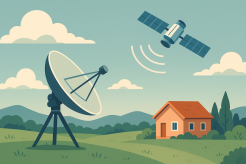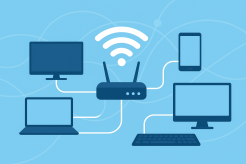2025’s Fastest ISPs: Providers Leading the Race

In today’s world, a fast internet connection is no longer a luxury—it’s a necessity. Whether you’re streaming in 4K, running a remote business, gaming competitively, or just juggling multiple smart devices at home, speed makes all the difference. With internet technology evolving rapidly, 2025 has brought new advancements and surprising shifts in which internet service providers (ISPs) are setting the pace.
So, who’s truly leading the race for the fastest internet in 2025? Let’s break it down.
Why Internet Speed Matters More Than Ever in 2025
It’s not just about downloading a movie in seconds anymore. Internet speed directly affects how we:
- Work remotely: Video conferences, cloud-based tools, and VPNs demand reliable connections.
- Game online: Low latency can be the difference between victory and defeat.
- Stream and connect: Households now juggle smart TVs, AI assistants, and multiple devices.
- Adopt new tech: From smart homes to AR/VR, speed and stability are essential.
With 5G expansion and fiber becoming more widespread, the standards for “fast” have changed significantly in 2025.
The Criteria for Ranking the Fastest ISPs
When we talk about the fastest ISPs, it’s not just download speeds that matter. We’re looking at:
- Download Speed – How fast you can grab content from the internet.
- Upload Speed – Vital for creators, video calls, and cloud backups.
- Latency/Ping – Key for gamers and real-time communications.
- Consistency – Reliable speeds during peak hours.
- Availability – Nationwide coverage vs. limited regional service.
Top ISPs Leading the Speed Race in 2025
1. Google Fiber – The Benchmark for Fiber Speeds
Google Fiber has been a consistent leader thanks to its pure fiber-to-the-home technology. In 2025, it now offers symmetrical speeds up to 10 Gbps in select cities. While availability remains limited, it continues to set the gold standard for what internet speed should look like.
2. Verizon Fios – Symmetrical Speeds for Home and Business
Verizon Fios has expanded its reach in 2025, offering up to 5 Gbps symmetrical speeds in major metro areas. The company’s reputation for reliability and customer satisfaction has kept it at the forefront of the fiber race.
3. Xfinity (Comcast) – Cable Internet Reinvented
While cable internet traditionally lagged behind fiber, Xfinity’s DOCSIS 4.0 rollout has changed the game. With speeds reaching up to 4 Gbps in some regions, Xfinity remains a powerful choice where fiber isn’t available.
4. AT&T Fiber – Widespread Fiber Rollouts
AT&T has invested heavily in expanding its fiber network. In 2025, its multi-gigabit internet plans are available to millions of households, making it one of the fastest and most widely accessible ISPs in the U.S.
5. Spectrum – Hybrid Cable and Fiber Expansion
Spectrum has focused on improving consistency and lowering latency. With hybrid technology and ongoing fiber expansion, Spectrum now offers multi-gig speeds in competitive markets, making it a top contender.
6. Starlink – Satellite Internet That’s Getting Faster
Once known for higher latency, Starlink has surprised the market in 2025. With advancements in low-Earth orbit satellite technology, Starlink now delivers speeds up to 500 Mbps with reduced latency, making it a viable option in rural and underserved areas.
7. Frontier Fiber – Affordable Multi-Gig Plans
Frontier has made a comeback with its aggressive fiber rollouts, offering up to 5 Gbps speeds at competitive prices. It’s especially popular in suburban areas where other fiber providers haven’t expanded yet.
5G Home Internet – A Wild Card in the Race
Providers like T-Mobile and Verizon’s 5G Home Internet are shaking up the market with wireless home broadband. While speeds vary based on location and network congestion, some users see 1 Gbps+ speeds—a huge leap compared to just a few years ago.
What’s Driving the Race for Faster ISPs?
Several factors are shaping this year’s internet speed competition:
- 5G Expansion: Bringing high-speed internet to mobile devices and homes.
- Fiber Rollouts: Fiber is still the king of speed and stability.
- Technology Upgrades: Cable providers adopting DOCSIS 4.0 to stay competitive.
- Consumer Demand: Households need higher speeds for work, entertainment, and connectivity.
Which ISP Should You Choose in 2025?
Choosing the fastest ISP isn’t just about numbers on a speed test. Consider:
- Your location – Availability still varies.
- Your household needs – Gamers, streamers, and remote workers all have different requirements.
- Budget – Multi-gig speeds are great, but are they necessary for your household?
For example, if you’re in a city with fiber, Google Fiber or AT&T Fiber may be unbeatable. But in rural areas, Starlink or 5G home internet could be game changers.
The Future of Internet Speeds Beyond 2025
Looking ahead, we can expect:
- 10 Gbps+ speeds becoming mainstream in metro areas.
- Wider rural connectivity through 5G and satellite improvements.
- AI-driven network optimization, ensuring smoother connections even in high-demand periods.
The internet race is far from over—it’s accelerating.
Conclusion
In 2025, the fastest ISPs are setting new standards for speed, reliability, and accessibility. Fiber remains the leader, but cable innovations, 5G expansion, and satellite advancements are closing the gap. Whether you’re a gamer, a remote worker, or just want seamless streaming, there’s a provider racing to meet your needs.
The real question isn’t just who’s fastest today —it’s who’s building the internet for tomorrow.
Related Posts

Fri, Dec 5, 2025 12:20 PM
TechnologyWhy You Need a VPN Today (and How It Protects You Online)
Learn how VPNs protect your data, block tracking, and secure your connection across every device.

Thu, Dec 4, 2025 3:30 AM
Internet BundlesBest Fiber Internet Providers in the US : Fast, Reliable, and Worth It
Discover the top fiber internet providers in the US, their speeds, pricing, and customer satisfaction ratings. Find the best plan for fast, reliable, and uninterrupted internet.

Thu, Dec 4, 2025 3:17 AM
Internet Bundles cheap internet dealsHughesnet Satellite Internet Review: Plans, Pricing, Speed
Get an in-depth Hughesnet Satellite Internet review covering plans, pricing, speed, and performance. Learn whether Hughesnet is the right choice for rural or remote households

Wed, Dec 3, 2025 2:36 AM
Internet BundlesBest Cheap Internet Plans Under $50 a Month You Can Actually Use
Discover the best cheap internet plans under $50 per month with reliable speeds, unlimited data, and flexible options. Compare top providers and find the right plan for your home.

Wed, Dec 3, 2025 2:05 AM
cable dealWhat Can You Really Do With a 100 Mbps Internet Connection?
Discover what a 100 Mbps internet connection can handle, from streaming and gaming to remote work. Learn how to choose the right plan for your household.